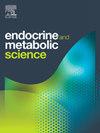Association between lipid profiles and Graves orbitopathy: A systematic review and meta analysis
Q3 Medicine
引用次数: 0
Abstract
Introduction
Graves orbitopathy (GO) is an autoimmune disorder affecting the tissues around the eyes, seen in 25–50 % of individuals with Graves disease (GD). Thyroid receptor antibodies (TRAb) target the TSH receptor, which can provoke an inflammatory response and promote fat cell formation by activating these receptors. Given this mechanism, statins that are commonly used for managing hyperlipidemia could be a potential treatment for GO. This review explores the connection between Graves orbitopathy and lipid profiles.
Method
This study followed the Preferred Reporting Items for Systematic Reviews and Meta-Analysis (PRISMA) guidelines. Articles were sourced from databases such as MEDLINE, ScienceDirect, EBSCO, ProQuest, Cochrane, and Google Scholar. The inclusion criteria covered both published and unpublished studies examining the relationship between GO and lipid profiles. Meta-analysis was conducted using Review Manager 5.4, and the risk of bias was evaluated using the Newcastle-Ottawa Scale (NOS).
Result
This review included a total of four cross-sectional studies. All studies found a significant association between LDL cholesterol levels and Graves orbitopathy. However, the relationships with triglycerides (TG), HDL levels, and total cholesterol (TC) were not consistently statistically significant. The meta-analysis revealed significant differences in TC, LDL cholesterol, and TG levels across all groups (SMD = 0.48, CI = 0.17–0.80, p = 0.002, I2 = 67 %; SMD = 0.42, CI = 0.18–0.67, p = 0.0008, I2 = 47 %; SMD = 0.24, CI = 0.07–0.41, p = 0.005, I2 = 0 %, respectively), while HDL levels did not show significant differences among the groups (SMD = 0.16, CI = −0.02-0.34, p = 0.08, I2 = 10 %).
Conclusion
Significant differences in serum lipid profiles, including TC, LDL, and TG except HDL, were found between patients with GO and those without. Further research is needed to confirm these findings.
血脂与Graves眼病之间的关系:一项系统综述和meta分析
Graves眼病(GO)是一种影响眼周组织的自身免疫性疾病,见于25 - 50%的Graves病(GD)患者。甲状腺受体抗体(TRAb)以TSH受体为靶点,通过激活这些受体,可以引发炎症反应并促进脂肪细胞的形成。考虑到这一机制,通常用于治疗高脂血症的他汀类药物可能是氧化石墨烯的潜在治疗方法。这篇综述探讨了Graves眼病和血脂之间的联系。方法本研究遵循系统评价和荟萃分析首选报告项目(PRISMA)指南。文章来源于MEDLINE、ScienceDirect、EBSCO、ProQuest、Cochrane和谷歌Scholar等数据库。纳入标准包括已发表和未发表的研究,研究氧化石墨烯与脂质谱之间的关系。meta分析采用Review Manager 5.4进行,偏倚风险采用Newcastle-Ottawa量表(NOS)进行评估。结果本综述共纳入4项横断面研究。所有研究均发现低密度脂蛋白胆固醇水平与Graves眼病之间存在显著关联。然而,与甘油三酯(TG)、高密度脂蛋白水平和总胆固醇(TC)的关系在统计学上并不一致。荟萃分析显示,各组TC、LDL胆固醇和TG水平存在显著差异(SMD = 0.48, CI = 0.17-0.80, p = 0.002, I2 = 67%;SMD = 0.42, CI = 0.18 - -0.67, p = 0.0008, I2 = 47%;SMD = 0.24, CI = 0.07-0.41, p = 0.005, I2 = 0%),而HDL水平各组间无显著差异(SMD = 0.16, CI = - 0.02-0.34, p = 0.08, I2 = 10%)。结论除HDL外,氧化石墨烯患者与非氧化石墨烯患者血清脂质谱(包括TC、LDL和TG)存在显著差异。需要进一步的研究来证实这些发现。
本文章由计算机程序翻译,如有差异,请以英文原文为准。
求助全文
约1分钟内获得全文
求助全文
来源期刊

Endocrine and Metabolic Science
Medicine-Endocrinology, Diabetes and Metabolism
CiteScore
2.80
自引率
0.00%
发文量
4
审稿时长
84 days
 求助内容:
求助内容: 应助结果提醒方式:
应助结果提醒方式:


